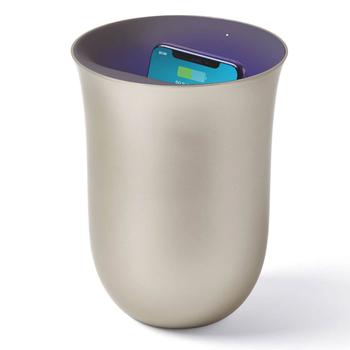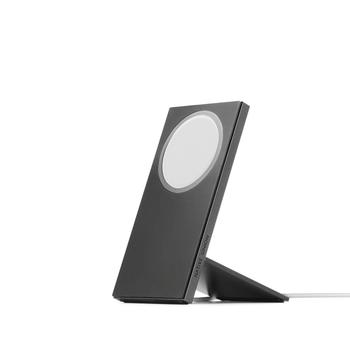Alessi Coffee Spoon
A great opportunity to take home an overview of the best of contemporary architecture: David Chipperfield, Denton Corker Marshall, Doriana e Massimiliano Fuksas, Hani Rashid, Jean Nouvel, Toyo Ito, Wiel Arets, William Alsop.
About Alessi
“A true design work must move people, convey emotions, bring back memories, surprise, and go against common thinking.” - Alberto Alessi
Founded in 1921 as a “Workshop for the processing of brass and nickel silver sheet metal, with foundry”, Alessi has always stood out for the high quality of its products. In almost a century of history, the company has gradually evolved to become one of the leading “Factories of Italian design”, capable of applying its expertise and excellence in design management to many different product types. Open to change and international development, Alessi at the same time has a strong bond with the traditions and cultural background of its area and continues to be synonymous with handcrafted objects produced with the help of machines.
Alessi’s mission is now one of translating its quest for the most advanced cultural, aesthetic, design and functional quality into mass production. Designer products are the result of the constant reconciliation of art and industry, of the “Immensity of Creative Potential” and the needs of the market. The company is committed to a design approach in which the most advanced expression of international creativity is always balanced against the desires of the general public. Alessi has been described as a “Dream Factory”, which uses its products to make people’s dreams come true, providing them with the Art and Poetry that they seek.
Alessi: The Design Factory
A journey inside and outside Alessi, to discover a Factory of Italian Design
Alessigraphy: the geography of Alessi production
SINCE THE COMPANY'S foundation in 1921 the majority of Alessi products have been manufactured through the cold working of metals, a tradition that is kept alive today by the skilled workers at the Crusinallo plant in Omegna.
Over time, Alessi also began to work with many other materials, such as porcelain, glass, wood, and plastic... A specific production method was developed for each one. Even when production takes place outside the Crusinallo plant, Alessi’s guidelines guarantee the company’s original production quality standards, continuing to reconcile industrial technological complexity with an artisanal eye for detail.
The objects produced from the different materials are manufactured in various production plants across the world. They remain original Alessi objects in that they are conceived with the same design excellence and produced with the same attention to quality that sets the company’s products apart.
The Designer:
Jean Nouvel
Born at Fumel, France, in 1945, Jean Nouvel, architect and urban planner, trained first in Bordeaux and then at the École Nationale Supérieure des Beaux-Arts in Paris, where in 1971 he graduated with the Diplome par le Gouvernement. After early work experience with Claude Parent’s practice, in 1970 he opened his first professional firm with François Seigneu and, in 1988, founded Jean Nouvel, Emmanuel Cattani et Associés (till 1994). He was a founder of the French Architects’ Movement (1976) and the Syndicat de l’Architecture (1979); he founded and directed the Biennale d’Architecture as part of the Biennale of Paris (1980); he was vice-president of the Institut Français d’Architecture (1991). Since 1983 he has received numerous awards and wide recognition in France and abroad, including the Leone d’Oro of the International Biennale of Architecture in Venice (2000), the Gold Medal of the Royal Institute of British Architects (2001) and the Praemium Imperial (2001). His principal works include the Institut du Monde Arabe in Paris (1981-87); the restoration of the Opera House in Lyon (1986-93); the Fondation Cartier pour l’Art Contemporain in Paris (1991-94); the Galeries Lafayette in Berlin (1991-96); the Cultural Centre Lucerne in (1993-2001).
The Designer:
David Chipperfield
Sir David Chipperfield CBE, RA, RDI, RIBA British, born 1953, London David Chipperfield studied at Kingston School of Art and the Architectural Association in London. After graduating he worked at the practices of Douglas Stephen, Richard Rogers and Norman Foster. David Chipperfield Architects was established in 1984 and the practice currently has over 200 staff at its offices in London, Berlin, Milan and Shanghai. The practice has won numerous national and international competitions and many international awards and citations for design excellence, including RIBA and AIA awards and the Stirling Prize 2007. In 1999 David Chipperfield was awarded the Heinrich Tessenow Gold Medal. In 2004 David Chipperfield was made an Honorary Member of the Florence Academy of Art and Design, and was appointed Commander of the Order of the British Empire (CBE) for services to architecture. He was appointed Royal Designer for Industry (RDI) in 2006, and in 2007 he was made an Honorary Fellow of the American Institute of Architects (AIA) and an Honorary Member of the Bund Deutscher Architekten (BDA). He was elected a Royal Academician (RA) in 2008 and awarded an Honorary Doctorate from Kingston University. In 2009 David Chipperfield was awarded the Order of Merit of the Federal Republic of Germany – the highest tribute that can be paid to individuals for service to the nation – and in the UK New Year Honours 2010 was named Knight Bachelor for services to architecture in the UK and Germany. The same year he was awarded the Wolf Foundation Prize in the Arts and the Grand DAI Award (Verband Deutscher Architekten- und Ingenieurvereine) for Building Culture. David Chipperfield received the RIBA Royal Gold Medal for Architecture in 2011. Given in recognition of a lifetime’s work, the Royal Gold Medal is approved personally by Her Majesty the Queen. David Chipperfield has taught and lectured worldwide. He has been Professor of Architecture at the Staatliche Akademie der Bildenden Künste, Stuttgart, and Visiting Professor at several schools of architecture in Austria, Italy, Switzerland, the United Kingdom and the United States, and is an Honorary Professor at the University of the Arts London.
The Designer:
Doriana e Massimiliano Fuksas
Studio Fuksas, led by Massimiliano and Doriana Fuksas, is one of the most outstanding international architectural firm in the world. Over the past 40 years the company has developed an innovative approach through a strikingly wide variety of projects, ranging from urban interventions to airports, from museums to cultural centers and spaces for music, from convention centers to offices, from interiors to design collections. With headquarters in Rome, Paris and Shenzhen, and a staff of 170 professionals, the practice has completed more than 600 projects and has worked in Europe, Africa, America, Asia and Australia, receiving numerous international awards.
The Designer:
Wiel Arets
Wiel Arets (1955) is an internationally renowned architect. He graduated from the Eindhoven University of Technology in the Netherlands in 1983, where he received a Master of Science in Architecture. He established his own office that same year, which later expanded throughout Europe. His writings and projects are published globally. Since 1989 he has continually taught at the world’s most distinguished universities. From 1995 to 2001 he was Dean of the Berlage Institute in Rotterdam, and in 2012 he was appointed Dean of the College of Architecture (CoA) at the Illinois Institute of Technology (IIT) in Chicago. An eminent critic, he was the President of the Jury for the 2012 Venice Biennale of Architecture, Chair of the Jury for the 2013 European Union Prize for Contemporary Architecture—Mies van der Rohe Award, and in 2014 he established, together with the CoA, the Mies Crown Hall Americas Prize (MCHAP), of which he is President of the Board.
The Designer:
Toyo Ito
Toyo Ito was born in 1941. He graduated from the University of Tokyo in 1965 and worked in the office of Kiyonori Kikutake until 1969. In 1971, he founded his own office Urban Robot (URBOT), which was renamed Toyo Ito & Associates, Architects in 1979. He is the recipient of many awards, including Golden Lion at the Venice Biennale, Royal Gold Medal from The Royal Institute of British Architects and The Pritzker Architecture Prize, etc. Among his best-known buildings are Sendai Mediatheque; Tama Art University Library (Hachioji campus); Torres Porta Fira (Spain); Toyo Ito Museum of Architecture, Imabari; National Taiwan University, College of Social Sciences (Taiwan R.O.C.); ‘Minna no Mori’ Gifu Media Cosmos, National Taichung Theater (Taiwan R.O.C.), etc.
The Designer:
William Alsop
Will Alsop, English architect and artist, was born at Northampton (1947), studied at the Architectural Association in London, worked with Cedric Price, Roderick Ham and Jan Störmer until early 2001, when he founded Alsop Architects, with branches in London, Rotterdam and Moscow. His most significant projects completed in these years were the Passenger & Ferry Terminal in Hamburg; Barrage & Visitor Centre in Cardiff; Le Grand Bleu Government Headquarters in Marseilles; the Tottenham Hale and North Greenwich Jubilee Line Underground Stations in London, the Reuters headquarters in Moscow; the State Archives in Hamburg. Alsop’s work and projects have received wide recognition and awards. His professional work has always been integrated with teaching. He died on 12 May 2018.
The Designer:
Denton Corker Marshall
The Australian Denton Corker Marshall Pty ltd firm was founded in 1972 in Melbourne by Barrie Marshall, John Denton and Bill Corker, who had all attended the University of Melbourne’s School of Architecture. The firm now has branches in Sydney, Hong Kong, Jakarta, Singapore, Ho Chi Minh City, London and Warsaw, with a total staff of over 160. The firm is active in architecture, urban planning, interior and landscape design. Its clients include major corporations and government bodies in Australia and abroad. The practice has worked on projects on the full range of scales, from private homes to urban enhancement projects; it has achieved wide recognition and won a number of awards. Among its most significant projects are the Australian embassies in Tokyo and Beijing, the First Government House in Sydney (a 64-storey tower and the Sydney Museum), the Exhibition Centre and the Museum of Victoria in Melbourne. In 1996 John Denton, Bill Corker and Barrie Marshall were awarded the Gold Medal of the Royal Australian Institute of Architects.
The Designer:
Hani Rashid
Rashid was born in Cairo in 1958. He studied architecture in Canada and in the United States, before opening his New York Asymptote Studio in 1988. He holds various teaches posts worldwide, and with his studio has designed a vast range of works that place him well ahead of his peers in the field of digital design. His projects span from experimental spatial installations to digital architecture. His most innovative works include two multi-dimensional and interactive architectural environments, i.e. the New York Stock Exchange Virtual Trading Floor and the Guggenheim Virtual Museum.






 英国商家
英国商家 转运中心
转运中心 海关检验
海关检验 用户签收
用户签收




















